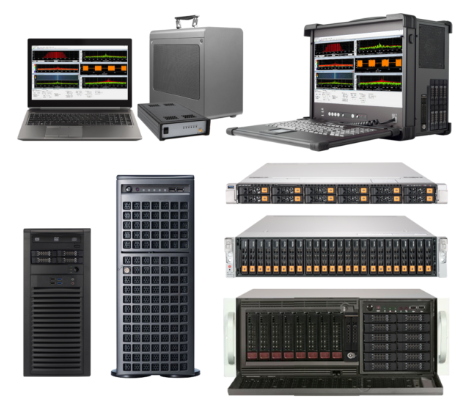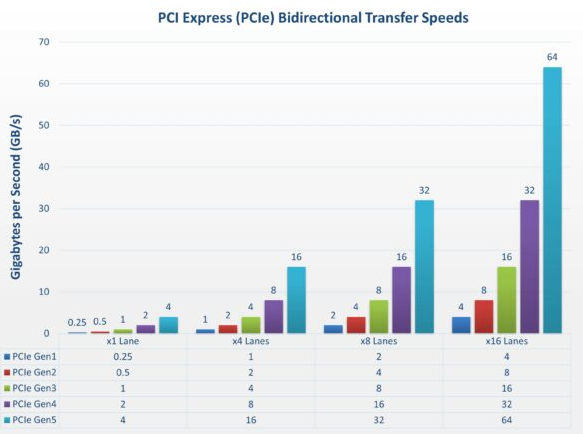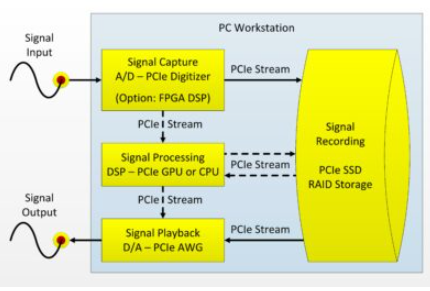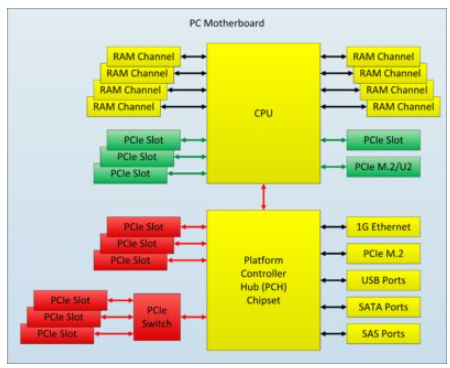Sponsored by GaGeReviewed by Maria OsipovaJul 26 2023
Data throughput speed and conversion resolution are the two most significant considerations for many measurements that require the capture and processing of analog data. Radar, Ultrasound Imaging, Signals Intelligence (SIGINT), Mass Spectroscopy / Time-of-Flight (TOF), Non- Destructive Testing (NDT), and Production Tests are typical examples. These test applications typically demand high-speed data transfer rates.
Arbitrary Waveform Generators (D/A) or Digitizers (A/D) residing on a high-speed backplane are typically needed. Often, these applications require real-time recording, processing/analysis, or playback, along with 2, 4, or more conversion channels and up to 16-bit resolution.
The conventional “box” type test equipment is typically suitable for user interactive measurements and relatively slow tests (less than 1000 readings/sec). However, the “box” type test equipment is not ideally suited to cases where continuous real-time high-speed data flow (greater than 10 MS/s) to a host PC is needed.

Image Credit: GaGe
As inside a PC, this real-time requirement can be suitably met using measurement cards with a high-speed back-plane interface.
Thanks to their ever-increasing capabilities, current PC-based systems provide the best open, flexible architecture and highest performance. They are the most cost-effective platform for constructing real-time high-speed data acquisition systems.
PC-Based System Platform Advantages Versus Conventional Signal Test Equipment
Oscilloscopes
Typically, digital designers use box-type oscilloscopes for R&D debugging and development. Given this specific use, they are optimized for an interactive user interface, with extensive front panel functionality and large color displays. The typical 8-bit oscilloscope resolution is suitable for viewing digital data on a linear amplitude display.
Most models, however, are limited in their memory capture depth. Such models are generally optimized for screen viewing speed and, as a result, boast excellent specifications relating to screen update rate in “waveforms/sec”.
Performance tradeoffs may frequently mean transfer rates to external computers are relatively slow. Usually, the measurement transfer rate is limited by the Ethernet or USB connection to the host platform. Data is usually transferred in non-continuous blocks. Finally, it is essential to note that high-end oscilloscopes can be extremely expensive, with long option lists that rapidly accumulate to thousands of dollars per unit.
PC-based systems, by contrast, can support high-speed multi-channel PCI Express (PCIe) based digitizers. Solutions like these offer high-speed A/D sampling rates and the highest dynamic range data, with wide (> GHz) analog bandwidth. Most importantly, these features are offered within a platform that supports high-speed storage systems, allowing multiple terabytes of continuous signal data capture recording in real-time.
Onboard FPGAs or GPU CUDA-based cards can also add embedded real-time digital signal-processing capabilities, and signal playback can be added via added D/A generator cards. These features are contained within a Windows environment for easy control and data handling.
Spectrum Analyzers
Most low-cost box-type spectrum analyzers operate to capture a large spectrum by way of swept tuning or by capturing many consecutive frequency bands, which are then pieced together to form the larger spectrum image. The better spurious free dynamic range (SFDR) performance versus wider band capture systems is one advantage of the swept-tuned or narrowband capture method.
A significant disadvantage for many applications, however, is that the frequencies on the display of spectrum analyzers are captured at different moments in time.
Therefore, most spectrum analyzers fall short when it comes to applications that require real-time capture of a large spectrum of interest and continuous recording for analysis.
Similarly to oscilloscopes, spectrum analyzers are optimized for screen viewing, and rather than the desired real-time continuous wide bandwidth recordings, most can provide only snapshots of data.
In contrast, a PC-based system with integrated PCIe-based digitizers (A/D) can easily record wide bandwidths without losing data. These solutions are ideal for IF signal data capture or baseband capture. This facilitates the capture, display and recording of the full wideband spectrum to high-speed integrated storage continuously with no breaks in the signal data record to produce multiple hours of recording.
Signal Generators
Many boxed-based signal generators help play repetitive and very simple waveforms. The complimentary PC-based system with an integrated PCIe Arbitrary Waveform Generator (D/A) delivers the same advanced capabilities for creating unique waveforms. Many terabytes of data samples can be utilized for replaying analog data from previously digitized analog signals.
This is useful when testing a new system’s response to real-world signals which have previously been recorded.
PC-Based System Platform Building Blocks
PCI Express (PCIe)

Figure 2. PCI Express (PCIe) Bidirectional Transfer Speeds in Gigabytes per Second (GB/s) for each Generation. Image Credit: GaGe
The Peripheral Component Interconnect Express (PCIe) standard is the key technology in enabling real-time high-speed data acquisition systems on PC-based system platforms. PCIe is the name given to a high-speed serial-based interface where each “lane” of a PCIe connection contains a transmit-and-receive pair of differential lines. These two lines form two serial channels capable of transporting data packets simultaneously in both directions between device link endpoints.
Peak data throughput scales with multiple lanes as packet data is striped across them.
Each generational implementation of the PCIe specification, as shown in Figure 2, has doubled the maximum data transfer rate speed of the prior generation while fully preserving backward compatibility with all previous generations.
These very high-speed PCIe-based interface connections allow the creation of real-time data acquisition systems by integrating targeted PCIe-based instruments, as depicted in Fig. 3.

Figure 3. Building Blocks of Real-Time High-Speed Data Acquisition System with Integrated PCIe Instruments. Image Credit: GaGe
Careful attention should be paid to the below to maximize the sustained data transfer rates of operating multiple devices simultaneously.
Architecture of Host System pcie Interfaces
- Pcie Gen Interface Type of Each Device
- Max. Sustained Transfer Rate of Each Device
PC System Platform
On modern PC-based platforms, PCIe lanes are allocated from the system processors (CPUs) or the system Platform Controller Hub (PCH) chipset. This is the process undertaken to add-in storage devices, to provide PCIe expansion slots for add-in card devices, or to facilitate onboard external device interfaces such as Thunderbolt, Ethernet, USB, audio, etc., as shown in Figure 4.
As represented in the green-colored block items shown in Figure 4, it is ideal for maximizing PCIe resources that do not share data bandwidth with other devices on the system platform.
PCIe lanes allocated directly from the CPU(s) can offer dedicated PCIe slots that do not share data bandwidth between slots. This provides maximum data transfer rate performance for multiple instrument cards operating simultaneously.
Typically, Workstation/Server class CPUs provide more native PCIe lanes resources than Desktop class CPUs, which therefore offer a more significant number of dedicated resources and PCIe slots.
As represented in the red-colored block items shown in Figure 4, desktop-class CPUs and platforms with fewer dedicated PCIe resources will, in contrast, allocate PCIe slots and resources provided via the system PCH and with added PCIe switches. As all devices connected via the platform chipset share data bandwidth to the CPU and other onboard devices (Ethernet, USB, SATA, etc.) that may negatively affect the maximum data transfer rates, caution with these resources is warranted.
PCIe resources behind a switch will typically auto default down to the lowest common PCIe device type, and PCIe switches may also be problematic. A generational mix of PCIe devices behind a switch can negatively impact data transfer rates.
For instance: If a PCIe Gen3 device and a PCIe Gen1 device are installed together behind a PCIe switch, the Gen3 device will auto-downgrade to a Gen1 rate to match the PCIe Gen 1 device, as a result of their shared connection via the switch to the system platform.
It is also possible to implement switches such that if only one slot is populated, it may run at up to a maximum x16 rate, but if two slots are populated, each device may only run up to a maximum x8 rate each and so on.

Figure 4. Simplified PC Motherboard Block Diagram. Image Credit: GaGe
High-speed storage devices are also bypassing the slower bottleneck data transfer rate limits of older traditional SATA- and SAS-based interfaces as they have transitioned to PCIe interfaces. Typically, PCIe-based storage devices utilize up to x4 lanes per device with multiple units striped together in a RAID-based configuration to enable highly high-speed data transfer rates.
PCIe-based storage devices for high-speed real-time operations are best maximized by utilizing PCIe lanes allocated directly from the CPU(s), just as with PCIe add-in cards, to not share data bandwidth with other system devices.
However, the fact that more dedicated PCIe lanes are allocated to storage units means that there are less dedicated PCIe lanes allocated to add-in card instruments and vice-versa. In light of this, applications that require multiple operating PCIe add-in card instruments and large high-speed storage will utilize two or more Workstation/Server class CPUs to provide more dedicated bandwidth PCIe lanes required.
One should consider the targeted application requirements with the total number of PCIe instruments and the effective data transfer rates to be sustained for each device operating simultaneously to ensure that the system platform can provide sufficient PCIe resources to support it when selecting a system platform for high-speed real-time operations.
PCIe Instrument Devices
For an integrated system solution, the functionality of traditional boxed-based test equipment can be supplied in PCIe-based form factor card instruments. As Figure 3 depicts:
- PCIe Digitizers perform A/D signal capture similarly to boxed oscilloscopes.
- PCIe FPGAs/GPUs or host CPUs provide digital signal processing for analysis similar to boxed spectrum analyzers.
- PCIe Arbitrary Waveform Generators perform D/A signal output/playback similarly to boxed signal generators.
However, PCIe-based instruments transfer data at significantly faster-sustained rates, which makes them significantly more suitable for high-speed real-time applications when compared to boxed-based test equipment. Boxed-based test equipment is limited in data transfer rates to a host system through external interconnection (typically via USB or Ethernet).
One should consider the following factors when selecting PCIe instrument devices:
- PCIe Streaming Support
- PCIe Gen Interface Type
- PCIe Maximum Sustained Transfer Rates
All PCIe devices do not support PCIe streaming operations. Many PCIe devices have a PCIe interface for conducting basic transfers to the host system and for means of supporting power for the device.
The term ‘basic transfers’ refers to moving data after the fact of initial operation is completed. For instance, a PCIe Digitizer may have onboard memory for the A/D capture operation. The capture is performed and subsequently stopped and the data residing in the Digitizer onboard memory may be copied to the host system.
This is different to a PCIe streaming operation in which data is continually operated on while simultaneously being transferred to another target device. For instance, a PCIe Digitizer continually acquires data on its signal inputs. At the same time, it streams the A/D captured data over the PCIe interface to high-speed storage to achieve signal recording of the data in real time until the entire operation is stopped.
Typically, a PCIe instrument supporting streaming operations utilizes a minimum dual-port architecture of its onboard memory to acquire data to onboard RAM, and simultaneously transfer the data from onboard RAM to the PC by interleaving write and read data packets.
The onboard memory, when in this mode, is effectively utilized as a large FIFO which provides ample data buffering between the host PC and the device. With high-speed DMA transfer mechanisms and circular memory buffers, data is transferred efficiently through the PCIe interface to the host PC system memory. This data transfer enables sustained and high-performance real-time streaming operations within a non-real-time operating system such as Windows.
Though a PCIe Instrument device will feature a specific PCIe generation and lane size type interface, this does not necessarily mean it will support that particular specification's maximum data rate bandwidth. Several factors may have an impact on the true sustained data streaming rate of a PCIe device, including the following:
- The maximum internal bandwidth of the front end of the device to its onboard memory
- The size and architecture of its onboard memory
- The capability and architecture of its PCIe interface
It is, therefore, key to check with the device manufacturer to determine if PCIe streaming mode is supported and, if this is the case, what the true maximum sustained data streaming rate is that can be supported to the host PC system.
PCIe Instrument Devices
A key advantage of the open PC-based system platform is that it facilitates the capability to mix and match very high-speed data transfer rates via the PCIe interface with a range of instruments tailored for a specific application requirement.
The modularity of a PC-based system platform allows for flexibility of future modification or upgrade capability without replacing the whole system, unlike traditional boxed-based test equipment whose functionality is set and non-upgradeable.
Engineers can design and deliver best-of-class high-performance real-time systems at a reduced cost and development time than closed proprietary-based systems by leveraging the latest commercial off the shelf (COTS) computer components.
Signatec has a long and rich history of offering high-speed real-time signal acquisition, recording, processing, and playback systems on PC-based platforms. This expertise eliminates uncertainties and risks with self-integrated systems, saving customers time and expense.
For more information on Signatec systems tailored to individual application requirements, visit www. signatec.com or feel free to reach out to the team at [email protected] or (815) 838-0005.
Produced from materials originally authored by Gerald Allgaier, Systems Specialist and Bob Fitzgerald, Application Specialist from Vitrek.

This information has been sourced, reviewed and adapted from materials provided by GaGe.
For more information on this source, please visit GaGe.